At first glance, Mont Saint-Michel is a fantasy sketchbook come to life: a crown of jagged rock and spires perched directly on the surface of the sea. It shimmers on the horizon when it is misty, and seems to float above the flat tidal flats at low tide. By the evening, the abbey is a golden spectacle as the sun sets in the bay.
Mont Saint-Michel has inspired wonder and awe for more than a millennium. Pilgrims toded across the perilous sands for centuries, and still tourists crowd the tides every day. Stepping at the bottom of the mount’s steep village lanes, the cries of seagulls above your head and the crashing tide below, it is easy to feel that you have landed simultaneously in the Middle Ages and in the 21st century.
One more thing: Mont Saint-Michel is not just a postcard photo or a video from above. The island is still alive with people and the weight of history. The monks still pray in the abbey. The creperies are still in the lower town. The tides are every bit as unpredictable and dramatic as ever, lapping the steep stone walls twice each day, sometimes engulfing the mount entirely, sometimes leaving it stranded on a flat sea of sand.
Few places in France are quite as vibrant, as textured with history and layers of stories, as Mont Saint-Michel. It is a full experience, one that challenges you with its climb but rewards you with views that sear themselves into your memory. Step onto the causeway and onto the mount: you have entered not a destination, but a legend.

Mont Saint-Michel Quick Facts
📍 Location: Normandy, France, about 1 km off the country’s northwestern coast in the bay where Normandy meets Brittany.
🏗️ Construction Period: Began in 708 AD as a sanctuary; major abbey structures built between the 11th–16th centuries.
🏰 Architectural Style: Romanesque foundations with soaring Gothic additions, crowned by a neo-Gothic spire.
🎭 Famous For: Its dramatic tides, medieval abbey, pilgrimage history, and breathtaking silhouette rising from the sea.
👑 Notable Figures: Saint Aubert (bishop who founded the sanctuary), William the Conqueror (supporter of the abbey), Archangel Michael (to whom the mount is dedicated).
🏆 UNESCO Status: UNESCO World Heritage Site as Mont-Saint-Michel and its Bay since 1979.
🌐 Official Website: https://www.ot-montsaintmichel.com

History & Legends
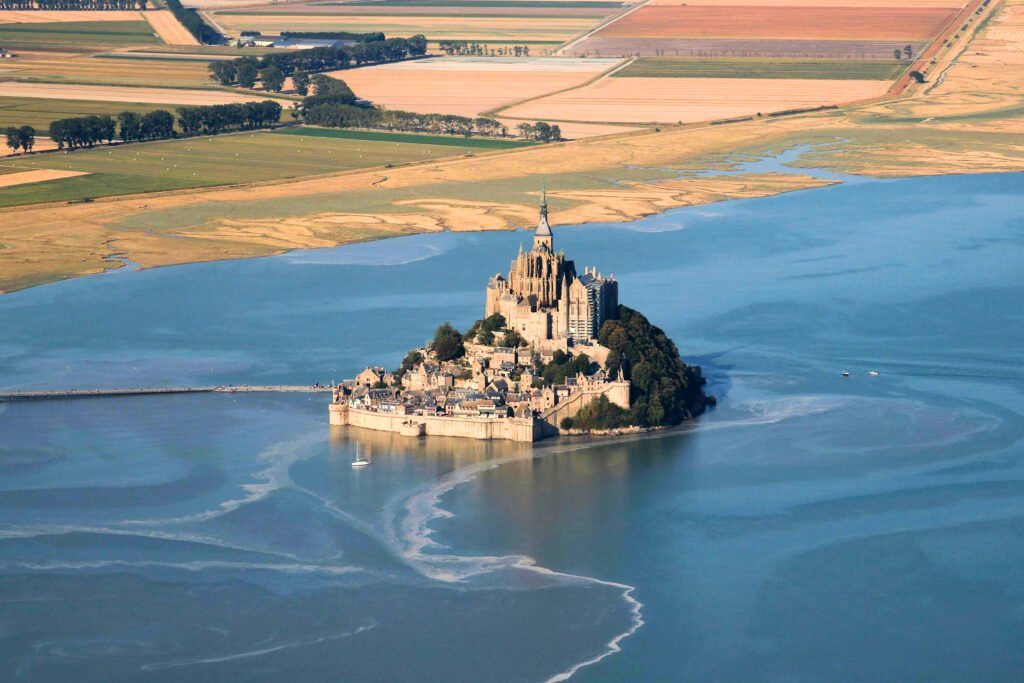
Before there was a postcard icon, before UNESCO and ecotourism and millions of visitors each year, there was a lonely rock jutting out into the sea. Windblown and unremarkable, Mont Saint-Michel was subject to the rhythms of tides and weather in equal measure. Fishermen skirted its shores (for there were quicksands along the banks of the bay), and shepherds knew of its presence. But nothing special happened on the tidal islet until the early 8th century AD.
Legend says that Aubert, the bishop of Avranches, received a vision of the Archangel Michael in 708 AD. In his dreams, the celestial protector of heaven told Aubert to build a sanctuary on the island rock. Aubert was not exactly quick to comply; he may have been less than convinced or perhaps simply overwhelmed. But Michael, apparently in no mood for arguments, is said to have tapped Aubert on the skull with his own wing to emphasize his point. The skull, with a small hole in the same place, is still on display in the cathedral of Avranches to this day.
Whether miracle or marketing, Aubert built the first chapel on Mont Saint-Michel. A simple shrine, it hung above the tides on the tidal islet. The position, halfway between earth and the sea, meant that pilgrims began to journey to the mount. Crossing the tidal sands was an act of both faith and bravery, and for pilgrims of the Middle Ages, any place where one could seek the protection of heaven was worth the peril.
The Abbey
By the 10th century, the simple chapel had evolved into a full monastery, run by Benedictine monks. Towers and cloisters began to rise; stone walls were built to hug the slope of the mount. The monks called it Mont-Saint-Michel au péril de la mer, “Saint Michael’s Mount in peril of the sea,” for the tides are some of the most dramatic in France. Sea water pours in at the speed of a galloping horse, to quote the locals. Land, sea, danger, and the power of God: the abbey has been a reminder of these boundaries since the dawn of time.
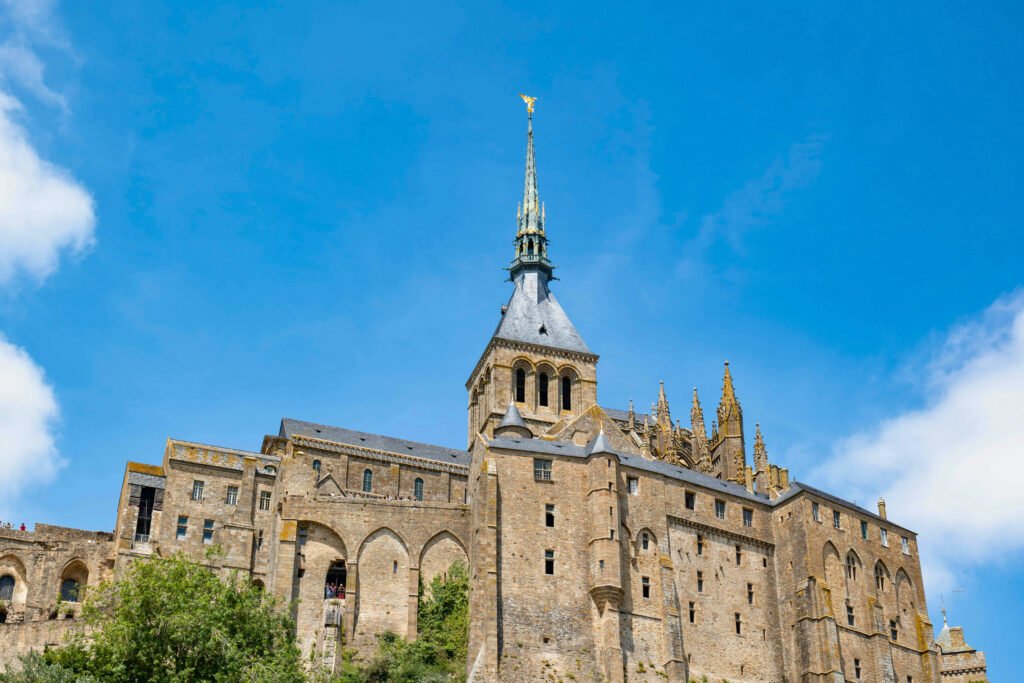
The Fortress
Mont Saint-Michel was as holy as it was strategic. It sat right on the dividing line between Normandy and Brittany, and for a long time, it was a desired fortress, a prize for the mightiest kings and dukes of each region. During the Hundred Years’ War (14th and 15th centuries), the English set siege to the abbey for decades. But while English armies repeatedly approached Mont Saint-Michel and encamped in the sands to attack it, they were never successful. The abbey’s steep stone walls were stout and the defenses tight, and its isolation often won the day. French propaganda of the time sang the praises of Mont Saint-Michel, and the mount became a national symbol of resistance.
You can imagine the scene: monks in their black habits moving quietly through the candlelit corridors and halls; soldiers tense on the ramparts; townspeople scurrying between the tiny streets, all while waves crashed against the base. Each time that the tide cut off Mont Saint-Michel from the mainland, you can be sure that its residents saw it as divine intervention.
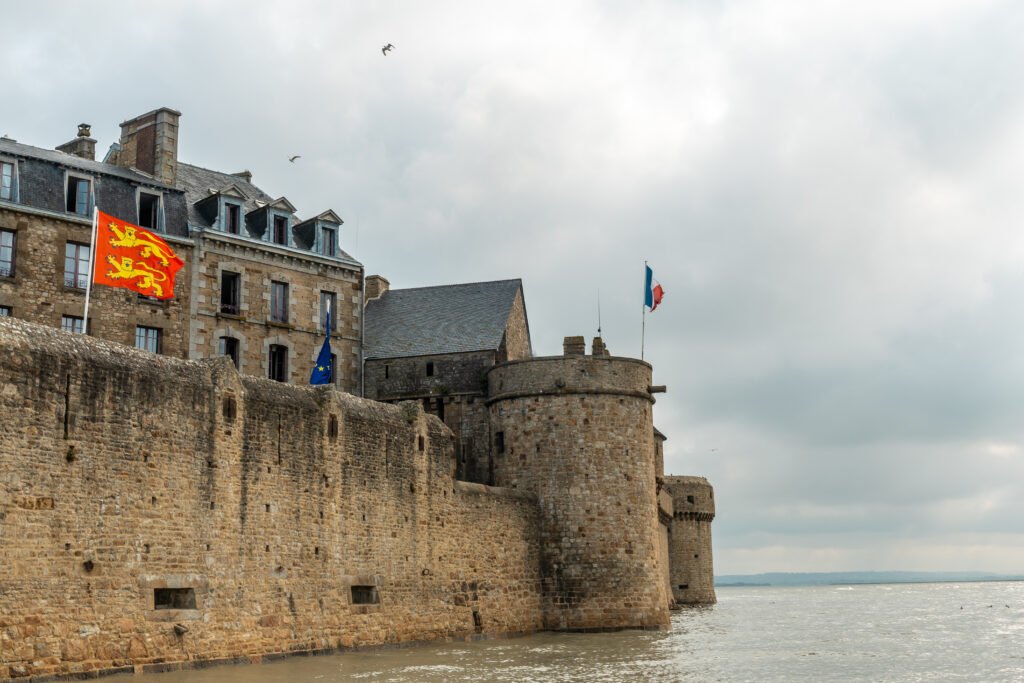
Pilgrimage
Pilgrimages to Mont Saint-Michel joined the other great pilgrimage routes of the Middle Ages: Santiago de Compostela and Rome. By the 11th century, hundreds of people were making the trek to the abbey each year, many coming to pray to the Archangel for protection or mercy. By the 13th century, architects were piling stone after stone onto the mount, and Mont Saint-Michel had taken on the Gothic marvel of the present day. Kings and nobles gave to the abbey, and it prospered, its faithful seeking its heights as penance and its climb as a physical test of the climb to heaven itself.
The highest point of Mont Saint-Michel is only around 60 metres above sea level, but in the Middle Ages, reaching it was not an easy task. The narrowest path to the abbey is only 2.7 meters across, and some visitors will tell you that the new visitor centre and pathways have made the mount too accessible. It is still not for the faint of heart or with weak knees, but the views from above more than make up for the climb.
The sanctuary also became a centre of learning and culture, and manuscripts were copied in its scriptorium. At its height, hundreds of monks called Mont Saint-Michel their home, and the abbey’s chants could be heard across the bay during dawn and dusk prayer services. For pilgrims arriving after an arduous journey across France, seeing Mont Saint-Michel rising above the misty bay must have seemed like stepping into paradise itself.
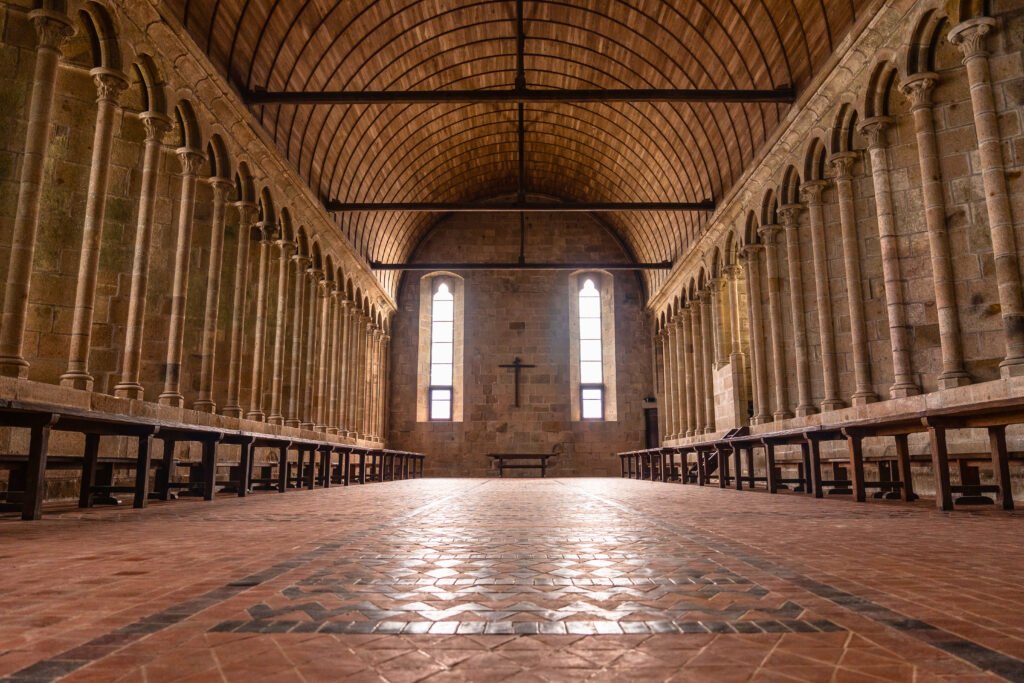
The Siege
As the Middle Ages gave way to modern times, Mont Saint-Michel’s flow of pilgrims and its standing as a centre of learning and culture began to dwindle. By the time of the French Revolution in 1789, monks had all but vacated the mount. Monasteries and churches were loathed by revolutionaries with little understanding of cultural heritage. Mont Saint-Michel was not spared, and the great abbey was turned into a prison. Cells were built into the stone walls and rooms; the great refectory, where monks had once dined, was now a barracks for convicts. Mont Saint-Michel became known as the “Bastille of the Sea”.
For nearly 80 years, the sacred space was hollowed by screams and clanking chains rather than prayers. It was not until 1863 that the island prison was shut down and restoration efforts began. Writers such as Victor Hugo rallied to save Mont Saint-Michel, and a new chapter in the abbey’s history was on the horizon.
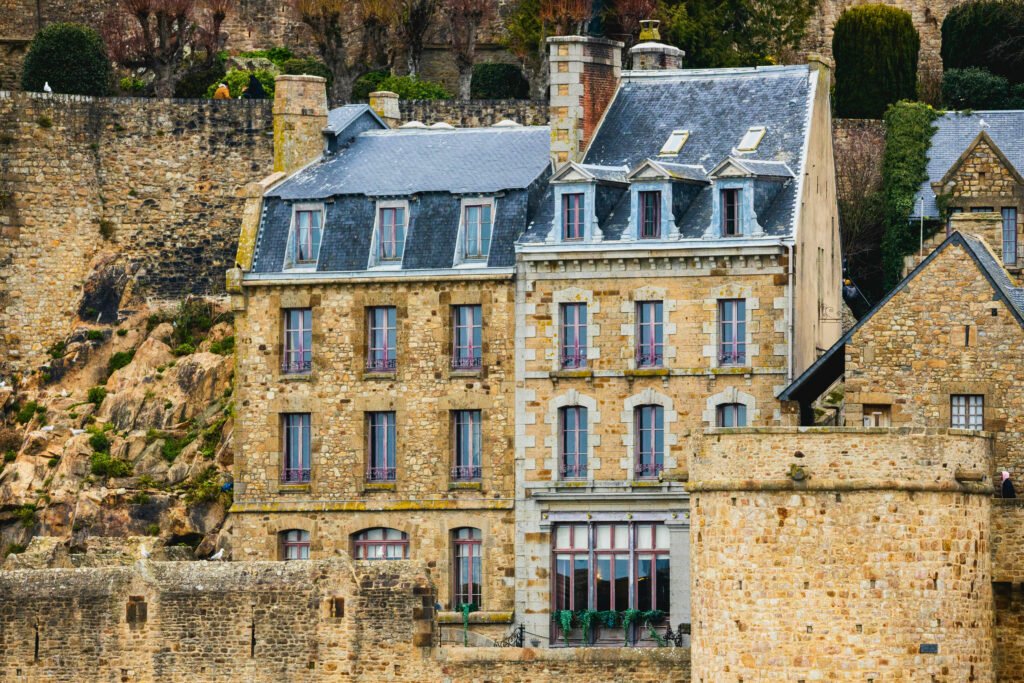
The legend Today
These days, the pilgrimage route is no longer much of a pilgrimage. Instead, 3 million people a year visit Mont Saint-Michel, and many tourists take the electric shuttle bus across the causeway from the mainland in lieu of the ancient walk. But the stories and legends are just as strong. Locals will still retell the tale of Aubert’s skull. Visitors are told of the power of the tides, both feared and revered. The symbolism of Saint Michael has always been strong, and to many it is a reminder of the mount’s strength and protection: the archangel with his golden wings catching the sunlight, his sword at the ready, and the dragon at his feet.
Visitors will often book their trip to Mont Saint-Michel expecting a historic site. Many leave the mount changed, having experienced something more. It is a palimpsest of history, from sacred visions to medieval sieges, humble pilgrimages, revolutionary upheaval, and romantic rediscovery. It is a history and a story of resilience, a transmutation, a cultural centre where people once exchanged and created stories in manuscripts. Now each visitor adds a new story to the tapestry.

Architecture & Atmosphere
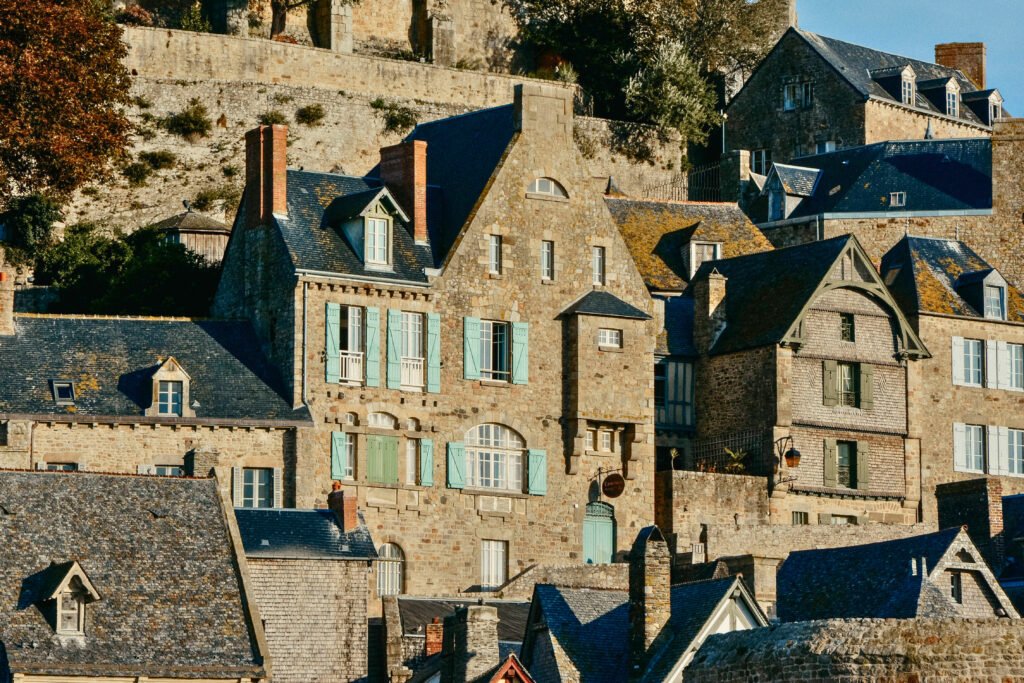
Climbing the lanes of Mont Saint-Michel is like walking back through time. At the bottom, the medieval village stretches out with its rowdy blacksmiths, merchants, inns, and creperies. Timbered houses lean over the cobblestone streets, flagons are set up for sale, and locals and tourists alike chat in the squares. You hear the cries of seagulls and feel the sea breeze coming off the flats at the back. But as you make your way up, street by street, path by path, it all gives way to the abbey. It is a stone after stone testament to medieval architecture, climbing layer upon layer up the granite base of the island.
The village Below
The lower town is where the Mont Saint-Michel story begins for most visitors. Blacksmiths, bakers and shopkeepers once provided the pilgrims with their last wares on their way to the abbey at the top of the mount. Now the medieval feel is back, but tourism has replaced pilgrimage as the lifeblood of the economy. Hidden squares open suddenly from the narrow passages. A row of sturdy stone ramparts flank the village, their slit windows trained on the sea. From here, visitors can see the tides lapping in, sands shifting beneath the silver water in the changing light.
The climb to the Abbey
The walk is steep, but the story is even steeper. The Grand Degré, a long stone staircase, funnels you upward between stout gates and defensive towers, past the hammering of blacksmiths. The air is less salty as you go, the shouts of tourists below recede, and the cries of seagulls seem even closer to the mount. It’s not just a climb of stone, but an ascent of atmosphere as you leave the village behind for the abbey.
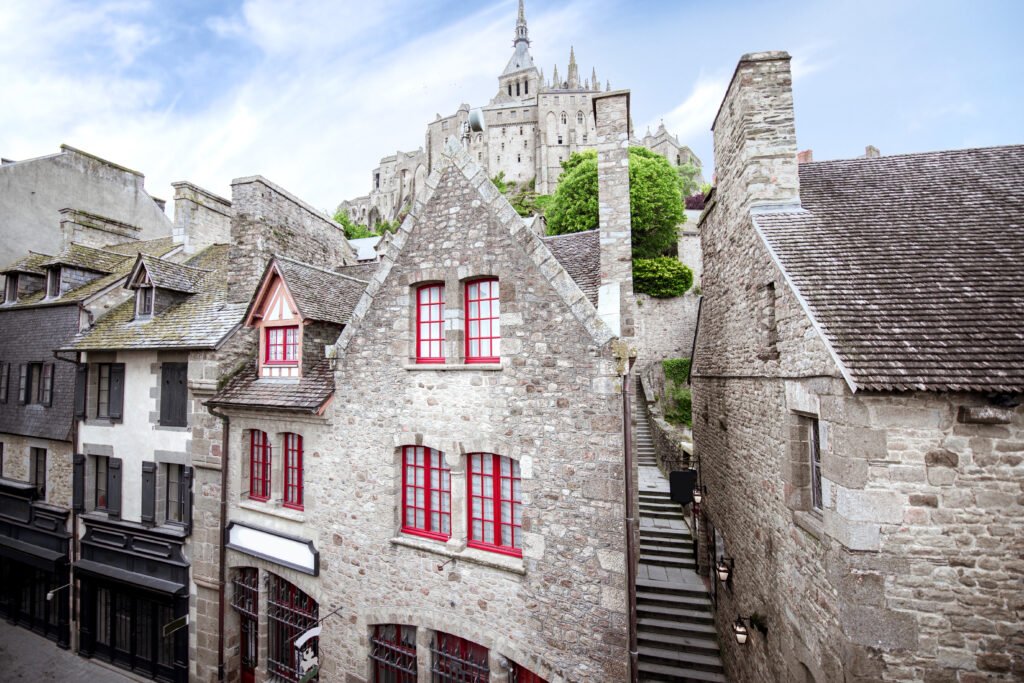
The Romanesque Foundations
Emerging from the covered streets of the village is a vertical timeline, with the earliest part of the abbey complex in Romanesque arches and thick stone walls. These are the oldest bones of the complex, dating back to the 11th century and built for both simplicity and endurance, to withstand the weather and potential attackers. In the dim spaces of the crypts and Salle des Chevaliers (the Knights’ Hall), time itself seems to pile in on you, a tower of stone. Columns grow out of bare stone floors like a forest, holding up the great bulk of rooms above.
The Gothic Marvel
What medieval pilgrims found at the top must have made the arduous journey up the narrow paths of Mont Saint-Michel worth it. Generations of builders dared to reach for the heavens after the 11th-century foundations, and the Gothic additions to the abbey gave it the silhouette it has today. This is nowhere more true than in La Merveille, “the Marvel”—a three-storey structure hugging the north side of the rock. Pointed arches take the eye up and up, the ribbed vaults floating overhead as if suspended by invisible strings, the light pouring in through thin lancet windows. For medieval pilgrims, this may have been like entering a vision of heaven.
The most breathtaking part is the cloister, clamped to the top of the rock as if a gale force wind might blow it away. Columns frame the view of sea and sky, and a strip of green garden is planted in the centre, a moment of silence between the soaring walls. The cloister was not built for visitors: it was a space of contemplation for the monks. But even today, the air seems to thrum with silence as you make your way through.
Defences and Ramparts
While Mont Saint-Michel is first and foremost a sanctuary, it is not without defences. Mont Saint-Michel also has its military side, and if you look up, you can see the battlements and wall that encircle the mount, including guard towers and stout gates. Cannons were added to these during the Hundred Years’ War, and English forces, who camped in the sands to try to take over the abbey, never succeeded. The distance from the battlements is misleading, and Mont Saint-Michel used to have a drawbridge. Stand on the battlements and look out at the flat sand extending for miles and miles, and it is easy to imagine enemy troops at the base of the mount, stranded by the incoming tide and cut off from retreat.
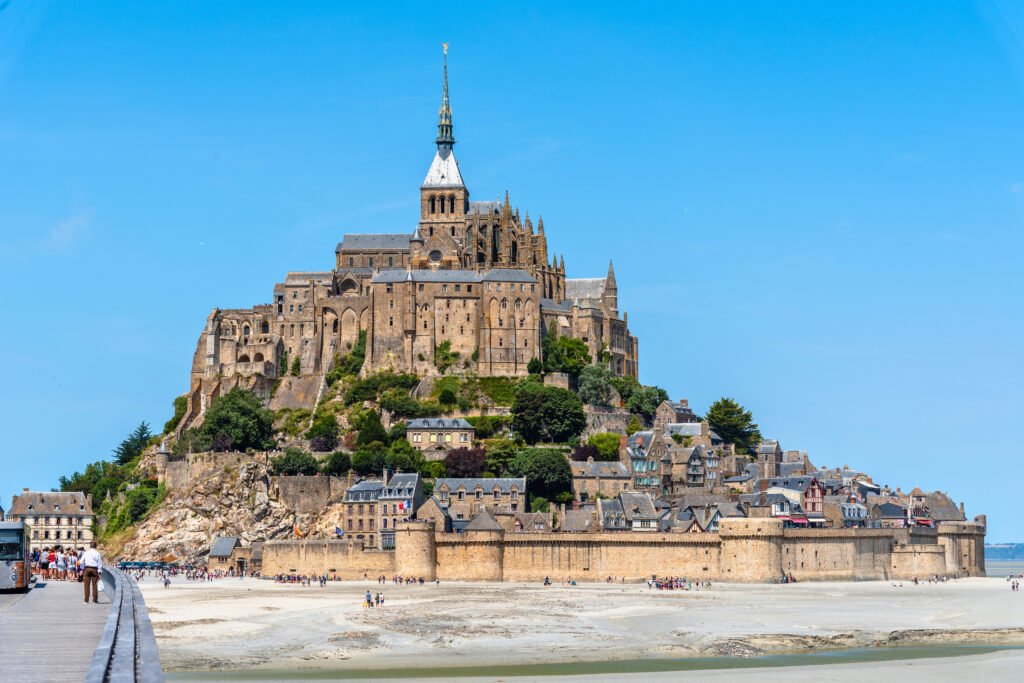
The Atmosphere of the Tides
What is perhaps the most powerful part of Mont Saint-Michel’s architecture is not built at all. It is the sea and the light. Twice a day, the tides transform the setting of Mont Saint-Michel. At low tide, an endless sea of sand stretches to the horizon, patterns of ripples and tiny streams swirling across its surface. At high tide, the sea crashes in, sea and foam swirling in and surrounding the mount. The contrast is so dramatic that first-time visitors to Mont Saint-Michel often stop to watch it over and over.
At sunrise, Mont Saint-Michel crests above the mist in the bay. At sunset, the abbey’s spire catches the last of the flame, and the golden figure of Saint Michael shines like a beacon above it all. At night, floodlights line the base of the walls and towers, and Mont Saint-Michel glows on the tide, an illuminated crown above the sea.
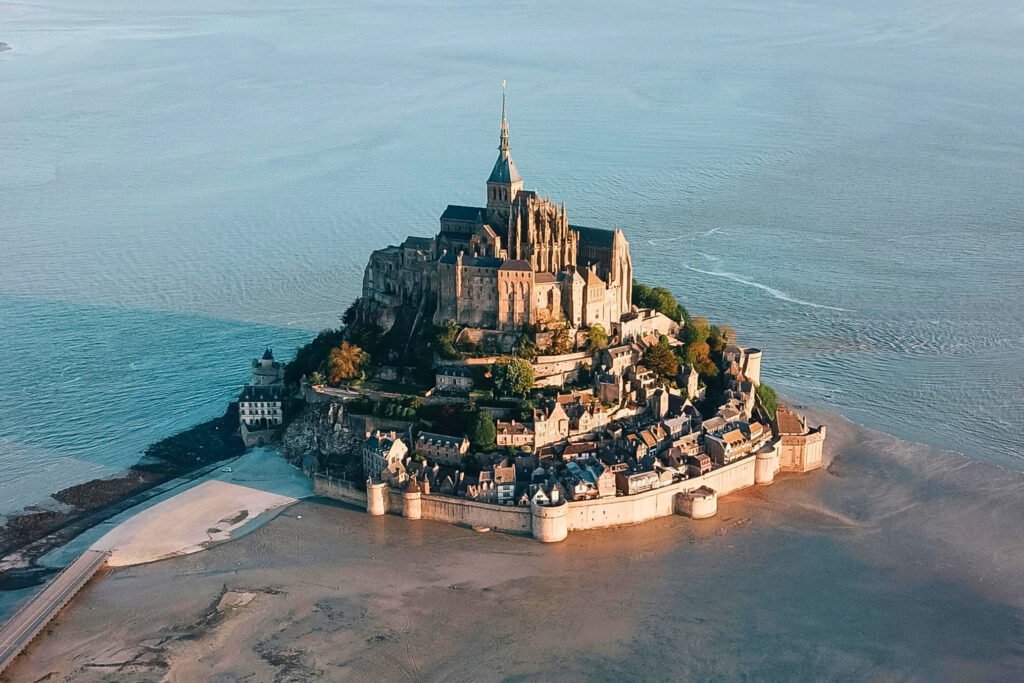
Mont Saint-Michel is Still Alive
Despite its grandeur, Mont Saint-Michel is not just a historical monument. It is alive with people. Monks from the Monastic Fraternities of Jerusalem still pray in its chapels. Bells toll from the abbey across the bay. Visitors, many fewer than during the Middle Ages, still make their pilgrimage to Mont Saint-Michel and climb the steep steps. Pilgrims have been replaced by tourists and visitors, but that sense of the sacred still lingers.
Part of what makes Mont Saint-Michel so unforgettable is not just the architecture. Nor is it the history. It is the combination: the weight of stone and history butted against the sweep of the tides, the power of nature, and the devotion of humans stacked on top of each other in layers and layers of stories. Walk the halls of the abbey, stand on its ramparts, look out at the sea and feel it retreat, advancing and receding, and you will understand why this small mount has inspired the world for more than 1000 years. It is not a castle, nor an abbey. It is an atmosphere, an experience chiselled out of granite and sea and light and lit by legend and folklore and above all, by the people who walk and visit and love it.

Visiting Mont Saint-Michel (With Real-Life Tips)
Visiting Mont Saint-Michel is not like visiting another spot on your sightseeing itinerary. It is not a place to tick off on your bucket list; it is a pilgrimage, a hike, and a time machine, all in one. Between the tides, the crowds, the hike uphill, and the sheer force of the place, some planning can make a difference to your experience. So here’s what you need to know before strapping on your walking shoes and heading towards that spire on the horizon.
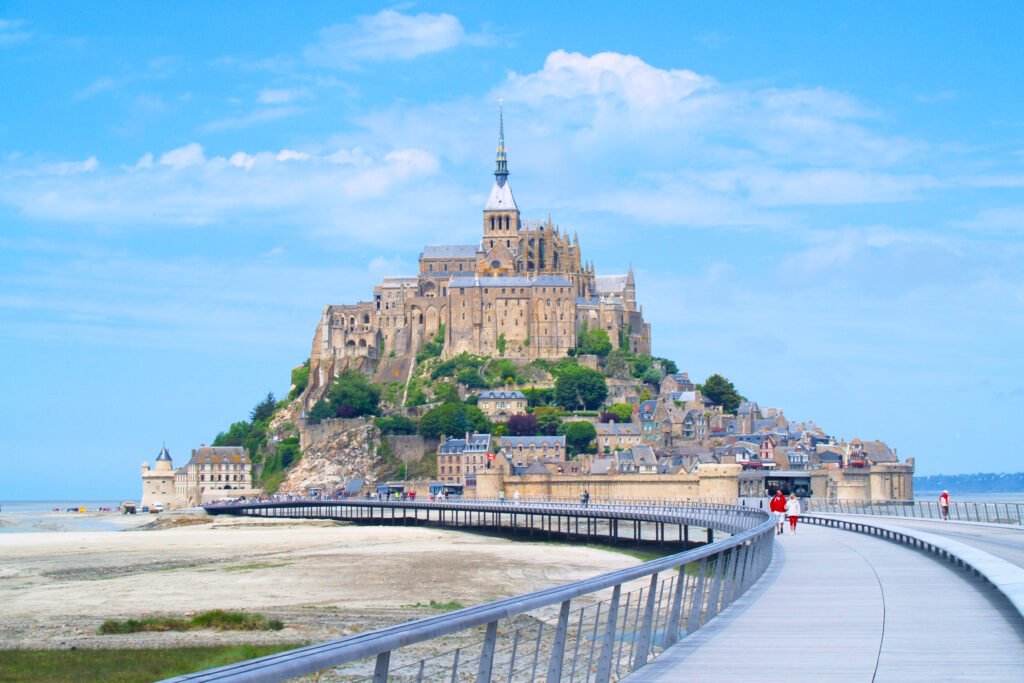
How to Get There
The vast majority of visitors to Mont Saint-Michel will set out from Paris, about 360 kilometers away. So you have a few options.
- By train: From Paris Montparnasse station, high-speed TGVs take you to Rennes in about 2 hours. Shuttle buses leave every 20 minutes or so from the train station in Rennes and go direct to Mont Saint-Michel in about 1 hour 15 minutes. You can also take a train to Pontorson, which is the nearest town, and then a short local bus ride to the mount.
- By car: If you’re driving, then your mobility increases tenfold, because you can then also explore the rest of Normandy and Brittany, driving off as far as Caen and Saint-Malo. The drive from Paris is about 4–5 hours (traffic permitting), and there is a large parking area on the mainland about 2.5 kilometers from the mount. From here, a system of shuttle buses (known locally as “Le Passeur”) run continuously and take you right down to near the foot of the island. If the weather’s in your favor, you can walk across the new causeway. The walk takes about 30 minutes, and the view of the abbey getting bigger and bigger as you approach is one of those sights that stays with you for life.
- On foot across the sands: Guided walks across the sands of the bay are one of the most magical ways to get there, but never, ever try to cross alone. Tides here run very fast, and the sands themselves harbor patches of quicksand. Experienced local guides can read the signs and point out the best safe routes, telling you interesting stories along the way. At low tide, you’ll walk barefoot through shallow streams of mud and sand, feeling like you’re on the beach, with the abbey shimmering at the end of the bay.
Planning Tip: If you want a less crowded experience, try to get to the mount itself as early in the morning or late in the afternoon as possible. Midday, especially in the summer, can be mayhem in the narrow streets.
Entry & Tours
Entering Mont Saint-Michel on foot is free—you can wander the village, walk the ramparts, and enjoy the views without spending a penny. But to really understand the magic of the place, you’ll want to go all the way to the abbey at the summit.
- Abbey Entry: As of 2025, a standard ticket is €16 per adult. Prices are reduced (€13) after 5:00 PM and between October and March. It is also free for under-25s from EU countries. This ticket includes entry to the abbey church, the cloisters, crypts, and exhibition spaces. Check the official website for the most up-to-date prices.
- Opening Hours: The abbey opens year-round, with opening hours that shift a bit between winter and summer. In general, 9: 00 am to 7:00 pm during high season, and up to 6:00 pm in the winter months. The last entry is allowed about an hour before closing. Check the official website in advance of your trip—hours can vary somewhat for religious services or restoration work.
- Guided Tours: Audio guides are available, but a live guide is a better bet. Human stories about the monks, sieges, and legends about Saint Michael will bring the place to life. Tours in English are offered at set times throughout the day. You can also book a private guide for a more in-depth experience.
- Combined Passes: If you’re traveling around the Normandy region, see if you can get a combined regional pass. These often include Mont Saint-Michel along with nearby Bayeux and Caen.
Insider Tip: Buy your tickets online in advance. Lines can be long, and in the peak season they snake out under the sun for quite a while.
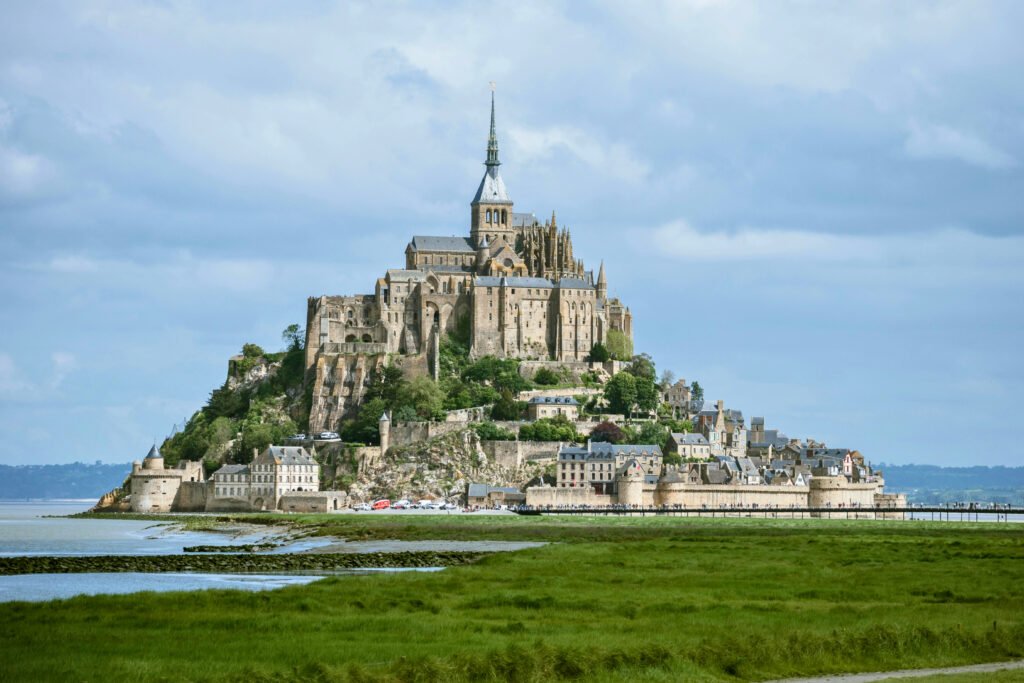
Best Time to Visit
Mont Saint-Michel is dramatic at any time of year, but your experience will be a bit different with the change of seasons and even the hour of the day.
- Spring (April–May): The flowers start to come out, and the air is fresh. Crowds are lighter than summer, so it’s a good time for photography and long walks.
- Summer (June–August): It’s high season, so prepare for long queues and packed streets. But the long days mean you can also come really early or linger until evening, when the tour buses leave and the mount becomes quieter.
- Autumn (September–October): Arguably the best compromise. Weather is still mild, the tides are dramatic, and the crowds are thinner.
- Winter (November–March): Winds whip across the bay, and some shops and restaurants close. But you also find yourself in a quiet, magical place. Imagine wandering almost empty, frost-dusted streets with the abbey glowing in golden light and no other soul in sight. It is atmospheric, even haunting, in the best possible way.
Tide Schedules: One of the mount’s greatest spectacles is the tide itself. On some days, the water surges in at a rate of knots, racing to encircle the island in less than two hours. Check the tide calendar before you go. High tides with coefficients of over 100 are the most spectacular, when the mount once again becomes a true island.

Accessibility & Tips
Be honest—it’s not an easy place to visit for everyone. The path up to the abbey includes steep stairs and uneven cobblestones. If you have limited mobility, it may not be possible to reach the top, but there is still plenty to see in the village streets and up on the ramparts.
- Wheelchair access: The lower town and main street are accessible. The abbey itself is only partially accessible, with wheelchair visitors able to access some of the exhibitions and chapels, but not the full climb.
- Shoes: Good sturdy shoes are a must. The cobblestones are slippery when wet, and the stairs can be tough.
- Food & Drink: Prices on the mount itself are high. If you are tight on a budget, make sure to stock up on snacks or sandwiches before the crossing. But if you’re in the mood to splurge, go all the way and treat yourself to a meal of mussels and fries (moules-frites) at one of the restaurants perched above the bay. The world-famous omelette de la Mère Poulard (fluffy, beaten to heaven) has been made here since the 19th century, though the price tag is to match.
- Staying Overnight: Most people visit as a day trip, but if you can, consider staying overnight. When the crowds have gone, the mount falls silent. Street lamps create little pools of light, abbey bells echo across the bay, and you feel as if you have stepped into the Middle Ages. There is accommodation on the mount itself (fairly small hotels), as well as more budget-friendly accommodation in the nearby town of Pontorson.
- Photography: Sunrise and sunset are the golden hours. At sunrise, the mount comes out of the mist. At sunset, the tide often reflects the spire like a painting. If you want to take shots without the crowds, get up on the ramparts just after dawn.
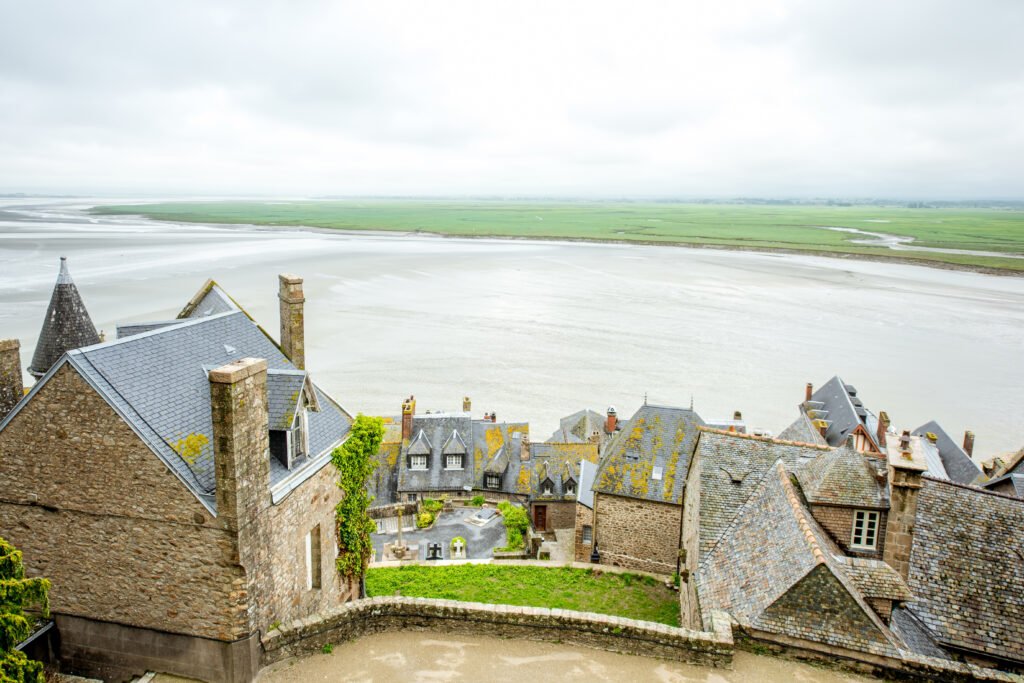
Personal Notes & Honest Advice
The first time I visited Mont Saint-Michel, I went at the worst possible time—I arrived at noon in August. I staggered up the main street shoulder to shoulder with the masses, jostling elbows with no room to even take in the view. By the time I reached the abbey, all sense of wonder was lost beneath the crush of humanity.
The second time I came in October. I got there early, well before 9: 00 am, while the shuttle buses were only just starting to arrive. The streets were practically empty, the tide was coming in, and the cries of gulls carried on the mist. It was like stepping into another century.
And so, here is my best advice to you: time your visit. Don’t just turn up mid-afternoon in the middle of summer and hope for magic. Come early, come late, or come off-season. Give yourself time not only to reach the top, but to sit on the ramparts, watch the water, and let the place seep into you.
Because visiting Mont Saint-Michel is not just about the abbey at the top. It is about the journey—to cross the bay, climb the cobbles, and travel through layers of history. It is about the moment when you pause, and turn around, and see the sea stretching behind you endlessly, and realize that you are here, at a place where nature, legend, and human devotion have converged for over a thousand years.
And if you’re lucky, you’ll leave not only with photos, but with the memory of a tide coming in, bells ringing high above you, and the mount glowing in the sky—an image that will stay with you long after you’ve walked back across the causeway.

Nearby Attractions
Mont Saint-Michel is, of course, the main event, but the region around it is also stuffed with lesser-known but equally-worthwhile spots. If you’ve made the journey this far, it’s well worth extending your trip by a day or two to see some of the following:
Saint-Malo
An hour’s drive west and you find Saint-Malo, another walled corsair city perched on the Brittany coast. Granite ramparts stretch around a maze of cobbled streets, seafood restaurants, and striped sailor-shirt shops. Walking the full circuit of the ramparts gives you panoramic views of the Channel, studded with tiny islands and tidal forts. At low tide, you can even scramble out to Fort National, perched defiantly on a rock outcrop.

Cancale
Closer still is the fishing town of Cancale. France’s oyster capital, where the locals sell oysters straight from wooden stalls in the harbor, often shucking them on the spot. Grab a dozen, squeeze on some lemon, and eat them with a view—literally. At low tide, you’ll be able to see Mont Saint-Michel shimmering on the horizon. If you fancy a sit-down oyster feast, Cancale’s restaurants also serve some of the freshest seafood you’ll ever taste.
Bayeux
Head east, and you will come to Bayeux and its legendary Bayeux Tapestry. A 70-meter-long embroidered narrative from the 11th century, it tells the story of William the Conqueror’s invasion of England in stunning detail. The town itself is a charming draw, too, with a Gothic cathedral and medieval streets that escaped bombing during the war.
Granville
Granville is a seaside resort to the north, but with a split personality: half-working port, half-holiday playground. Its clifftop old town is all winding lanes, while the lower harbor area bustles with fishing boats. Fashionistas can appreciate the Christian Dior Museum, which sits in the designer’s childhood villa high above the sea.
Avranches
Don’t miss Avranches, either, which has the closest ties to Mont Saint-Michel in terms of its history. It was here that Bishop Aubert had his vision of Archangel Michael. The town still houses the Scriptorial Museum today, which displays medieval manuscripts that were once created by monks of Mont Saint-Michel. The museum is modern and interactive, a pleasant contrast to the ancient stones of the mount itself.
Each of these places helps add layers to a visit to Mont Saint-Michel. They form a tapestry of Normandy and Brittany life: seafaring towns, medieval treasures, landscapes where history seems as much alive as the tides themselves.

FAQ: Visiting Mont Saint-Michel
How long should I spend on Mont Saint-Michel?
I’d recommend 4–5 hours at the very least. That gives you time to poke around the village at the bottom, climb up to the abbey and then amble about the ramparts.
Can you sleep overnight on Mont Saint-Michel?
Yes, but be warned: rooms are few, and they’re expensive. I highly recommend it, though. Overnight, the crowds disappear, and the mount seems to slow down, suspended in the stars. There’s something magical about it.
What time of day is best to visit?
Try to get there early in the morning or late in the afternoon. Avoid the middle of the day if you can. It’s when Mont Saint-Michel is busiest. Summer days are the worst: with each wave of visitors streaming in, the narrow streets feel crushingly crowded.
Is Mont Saint-Michel free to visit?
Yes, the village and ramparts are free to wander. The abbey, though, is around €13 for adults, with concessions for students and children.
Are the tides at Mont Saint-Michel dangerous?
Definitely. Mont-Saint-Michel Bay has one of the fastest tides in Europe. You shouldn’t attempt to cross it, or enter the surrounding flats, unless you’re with a local guide. Quicksand and shifting water are no joke.
Is Mont Saint-Michel wheelchair accessible?
The lower village is accessible in places, but the abbey is much less so, with steep stairs, steeply raked paths and uneven cobbles. Overall, it’s not a very friendly place for those with mobility issues.
Can you drive right up to Mont Saint-Michel?
No. There’s a car park on the mainland; shuttles and footpaths connect the parking to the mount.
How far is Mont Saint-Michel from Paris?
Around 360 km. By train and bus, it takes about 4–5 hours each way. By car, about the same.
What should I wear to Mont Saint-Michel?
Good, solid shoes. You’ll be climbing up a lot of steep cobbles and stairways. Bring a jacket or windcheater, too. Even in summer, it can be nippy out on the bay.
Do people still live on Mont Saint-Michel?
Yes. Only a few dozen people live on the mount itself these days, mostly in tourism, hospitality, or monastic service in the abbey.


Final Thoughts
Mont Saint-Michel is the kind of place that stays with you. It’s the effort involved in getting there: the steep climb, the throngs of people. But when you reach the top of the abbey and look out across a sea that seems to go on forever, it’s worth it. It always makes me feel awestruck, standing there in the moonlight, the wind in my face. Come for the legends of Saint Michael, or the medieval architecture, or the poetry of the tide, but don’t be surprised if the mount casts its own spell over you.
If you’re planning your visit, make sure to factor in enough time to experience it properly. Get there early, stay late, even spend the night. Watch the mount as the tides ebb and flow and you’ll understand why pilgrims, poets, and travelers have been making their way here for over a millennium.
💬 Have you been to Mont Saint-Michel? Or is it still on your bucket list? Drop a comment below or tag us on Instagram @CastleQuestChronicles—we’d love to hear from you!
👉 And if you’re after more travel inspiration, dive into our guides to Prague Castle and Himeji Castle—two more architectural wonders with their own epic stories to tell.
🏰✨Thanks for reading. If you found this article interesting, be sure to follow us along. We are also on Instagram, Facebook, Pinterest, YouTube, TikTok, and X. You can also see all our castle stories here! More castles (and more stories) are on the way.



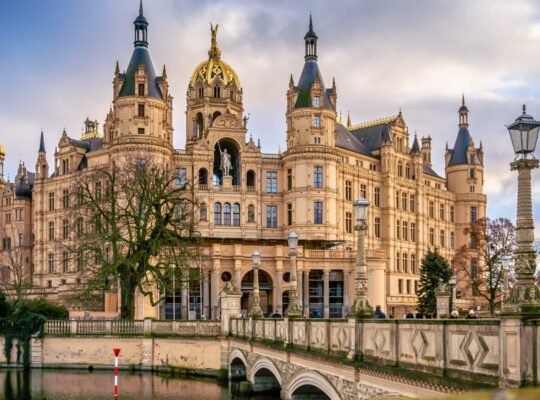

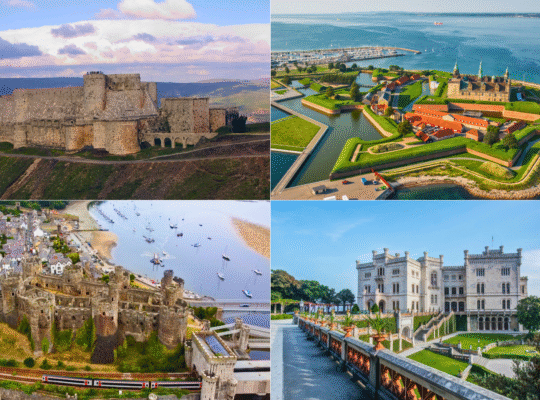
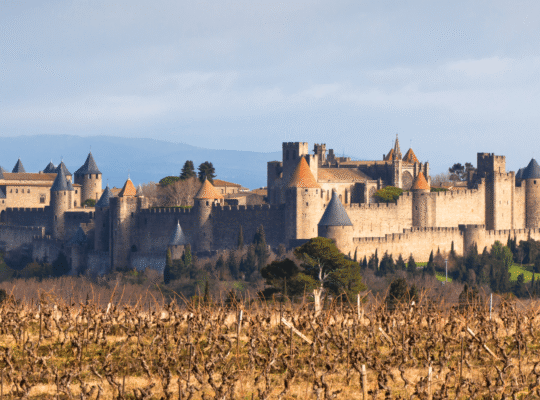

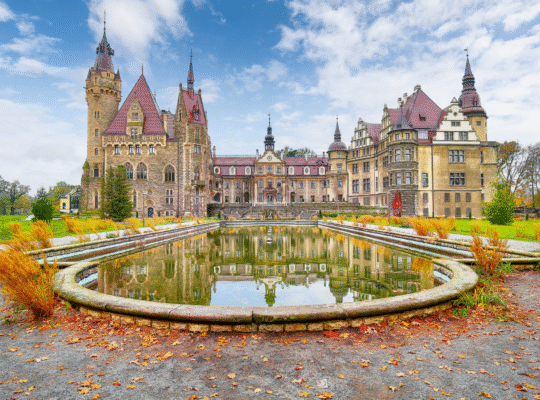


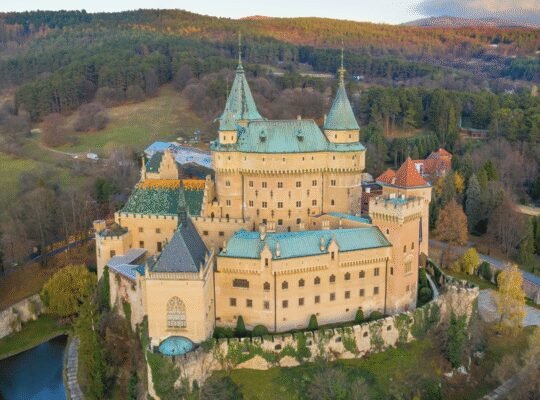
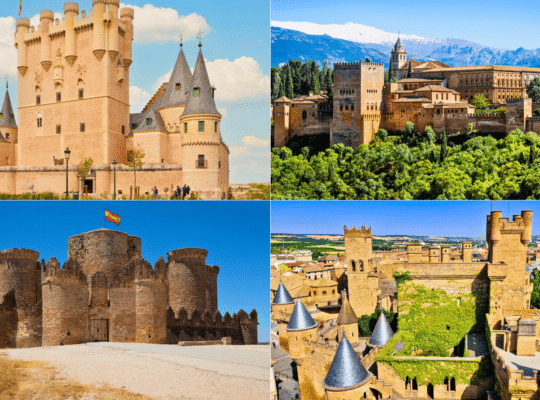
2 Comments